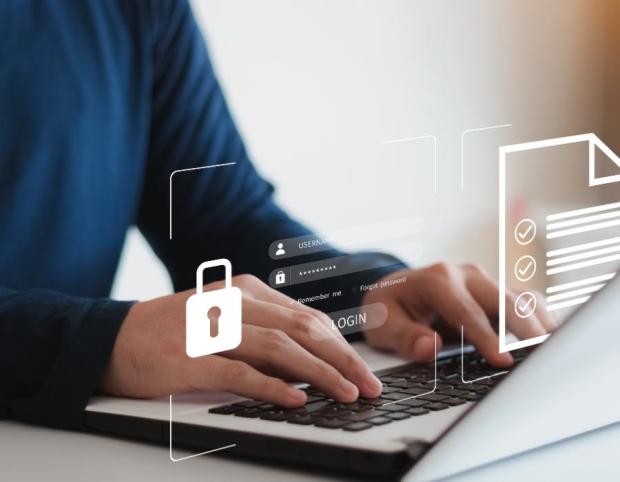Learn more about what you can expect from your online experience at Champlain.
Across the globe, the threat of data breaches and other web attacks looms large. In 2022 alone, more than 800,000 cybercrimes were reported in the United States. As businesses and individuals increasingly rely on information security and cybersecurity professionals to protect their data, understanding the essential elements of information security has never been more critical.
In fact, according to United States Bureau of Labor Statistics (BLS) data, the demand for information security analysts is projected to grow by 32% between 2022 and 2032. For those considering a career in information security, now could be a great time to get started.
So, what are the main components of information security, and how can industry professionals implement these principles in their everyday work? Let's dive in.
The CIA Triad: Core Principles of Information Security
In the information security field, three key elements are essential for protecting data: confidentiality, integrity, and availability.
Confidentiality: Safeguarding Sensitive Information
Confidentiality in information security refers to the ability to keep sensitive information private and ensure that it is only accessed by authorized individuals.
Integrity: Ensuring Data Accuracy and Trustworthiness
Another important tenet of information security is integrity, which refers to protections against unwarranted or unauthorized changes to files and other data. The idea behind integrity is that data should remain as reliable and accurate as possible, with no modifications or deletions made without authorization.
Availability: Reliable Access to Information When Needed
The last element of information security is availability, which simply refers to a system's ability to make data and files available when needed. Maintaining data availability typically relies on the system's overall infrastructure.
Implementing the CIA Triad at Work and Home
How can organizations and individuals apply these core principles of information security? Here are some tips and best practices that information security professionals should keep in mind.
Strategies for Enhancing Confidentiality
To improve data confidentiality as part of a larger information security plan, consider these strategies:
- Use encryption to protect against unauthorized access.
- Implement password protection and multi-factor authentication for added security.
- Regularly back up data to an off-site location to ensure recovery during a breach.
Best Practices for Maintaining Data Integrity
To maintain and improve data integrity as part of a security policy:
- Train employees on proper data entry and common-sense security measures.
- Keep audit trails on all data and files to track changes and access activities.
- Implement a solid error-handling process to identify and address data errors or integrity issues promptly.
Solutions for Ensuring Information Availability
Ensuring information availability is crucial in information security. Effective strategies include:
- Using software-based infrastructure with a business continuity or disaster recovery plan.
- Ensuring sensitive files and information remain accessible even in the event of a data breach.
The Role of Encryption in Protecting Information
Today, data encryption is one of the most heavily utilized strategies for improving information security. But what are the main components of information security, what exactly is encryption, and how does it all work?
Understanding Encryption and Its Importance
Encryption is a security method in which all data is essentially converted into ciphertext or code that is impossible to decipher or understand without a decryption key or password. It is commonly used to protect sensitive data from being accessed by unauthorized users and is highly effective in preventing file compromise.
Practical Applications of Encryption in Daily Life
Both individuals and organizations can use encryption to enhance information security. For example:
- Businesses commonly encrypt email and in-house messaging tools to keep information protected and private.
- E-commerce websites encrypt user payment information to prevent theft and fraud.
- Individuals are encouraged to use encrypted cloud storage for data backups, adding an extra layer of security.
Emerging Threats to Information Security

The world of information security and cybersecurity is constantly changing. As a result, information security professionals are responsible for staying on top of emerging threats and mitigating risks by being proactive.
Recognizing and Mitigating Cyber Risks
Regardless of the types of threats out there, information security professionals are relied upon to recognize and mitigate risks before they arise. Risk mitigation can be done proactively by running security audits regularly, which can identify potential vulnerabilities so they can be addressed quickly. Meanwhile, information security professionals may also mitigate the potential for an attack by removing unnecessary applications and programs from the data infrastructure, consolidating systems as needed, and implementing strict access controls within the organization.
Future Trends in Information Security Threats
Unfortunately, the frequency and size of cyber-attacks across the globe only continue to increase as new threats and attack types emerge. Currently, some of the most alarming information security threats are those related to:
- Ransomware
- Internet of Things (IoT)
- Malware and phishing
- AI attacks
- Social engineering
- Supply chain attacks
The Importance of Regular Security Audits
Among the most important tasks carried out by information security experts are regular security audits or comprehensive assessments of a company's overall information and cybersecurity. The primary purpose of a security audit is to identify potential risks and vulnerabilities so they can be remedied before an attack or breach occurs.
Conducting Effective Security Assessments
Security audits should be performed regularly to address changing threats as they emerge. Conducting an effective security audit begins with defining the total scope and gathering detailed information about security policies, software, applications, and devices. From there, security experts can use vulnerability scanning, penetration testing, and other special tools to identify risks.
Utilizing Audit Findings to Strengthen Security
Once vulnerabilities and risks are detected, information security experts can write reports and make recommendations regarding changes to policies and procedures that may address these concerns and improve overall security within the infrastructure. Additional assistance may be needed to help organizations implement these recommendations, and regular follow-ups are recommended to review the effectiveness of new security tools or measures.
Building a Workplace Culture of Security Awareness
One aspect of information security that is too often overlooked is workplace culture and training as a defense against data breaches and other vulnerabilities.
Training Employees and Family Members on Security Best Practices
All users who have access to a data infrastructure should be appropriately trained and informed on security best practices. At the business level, this training should extend to all users with access to company devices, such as computers. On the individual level, all family members who use household devices should be informed as to common security best practices, like the use of strong passwords. When everybody is informed, this can significantly reduce the risk of data breaches and other security issues.
Creating Policies and Procedures for Information Protection
Companies should establish policies and procedures for information protection in the workplace. These should cover:
- Creating strong passwords
- Identifying phishing schemes and attempted attacks
- Implementing access control measures
- Distributing these policies to all employees before they access company information

Advanced Security Technologies and Tools
As new threats emerge, the good news is that the industry is seeing new and advanced security tools and technologies coming into play. That said, what are the main components of information security that these new tools and technologies aim to protect?
Leveraging AI and Machine Learning for Security
Artificial intelligence (AI) and machine learning, for example, can be used to identify threats more effectively before they emerge, as well as for faster threat/incident response. As AI technology continues to improve, its potential applications for information security will only grow.
The Role of Blockchain in Enhancing Security
Similarly, blockchain technology is used to perform encryption and other methods of securing data. Because the blockchain is decentralized, it allows for better data integrity while simultaneously protecting against unauthorized access.
FAQs:
Below, explore answers to some of the most commonly asked questions about cybersecurity, information security, and related career paths.
What Is the First Step in Starting a Career in IT and Security Protection?
Those interested in a career in IT or information security and protection should pursue a formal education in a related discipline. Some common examples include degrees or certificates in information technology or computer science. A degree or certificate program can provide aspiring IT/security professionals with the foundational knowledge and skills they will need in the field.
How Often Should Security Audits Be Conducted?
The frequency with which security audits should be conducted depends on numerous factors, ranging from the company's size to specific risk factors. Generally, most businesses should get into the practice of performing a security audit at least once, if not twice, annually.
Can Encryption Be Broken, and How Can We Stay Ahead?
While data encryption can significantly increase security, the reality is that any encryption protocol can be broken with enough time and resources. The key to maintaining the effectiveness of encryption tools is to keep encryption keys safe while staying on top of evolving decryption technology, such as brute force tools and quantum computers.
What Are Some Simple Steps to Improve Information Security at Home?
To improve information and data security at home, individuals can: use strong and complex passwords, set up multi-factor authentication on accounts, install security updates on devices promptly, and regularly back up files and data to ensure recovery in the event of a breach.
What Are the Three Elements of Protecting Information?
The main three elements of protecting information are confidentiality, integrity, and availability. When considering information security, experts must keep these core elements at the forefront of their planning and action to optimize security measures and improve data security.
What Are the Objectives of an Information Security Policy?
The objectives of an information security policy can vary slightly from one organization to the next. However, information security policies aim to protect data from hackers. In some industries, information security policies may also be required to remain within industry compliance standards.
Pursuing Your Passion in Information Security
With so many threats lurking around the web, information security experts need to understand the critical elements of information security and how to implement them in their roles. In doing so, they can prevent unauthorized access to sensitive data while mitigating data loss and other costly security problems.
Interested in learning more about information security and pursuing a career in this growing field? Champlain College Online is proud to offer an undergraduate certificate in information technology fundamentals. This program is available 100% online and can be completed in as little as three terms, so learn more or get started with your online application today.
You May Also Like
Get Your Online Experience Guide
Learn what you can expect from your online experience at Champlain College Online.

Online Experience Guide Download
I acknowledge that, by clicking the "submit" button, I am giving my express written consent to Champlain College and its representatives to contact me about educational opportunities via email, text, or phone, at the phone number above, including my mobile phone, using an automatic dialer, or pre-recorded message. Message and data rates may apply. I understand that my consent is not a requirement for enrollment, and I may withdraw my consent at any time.






